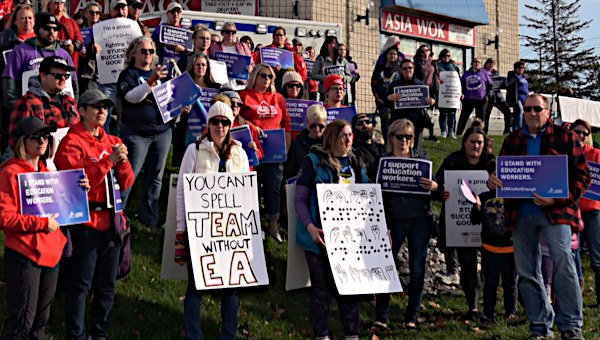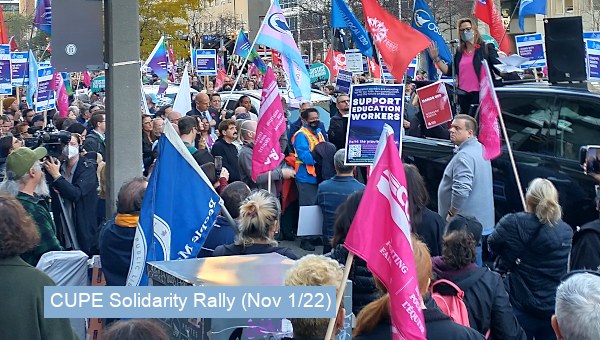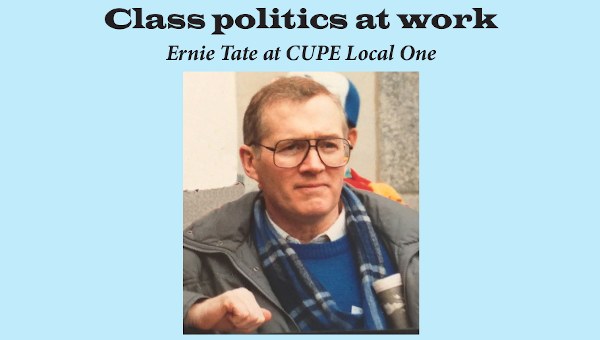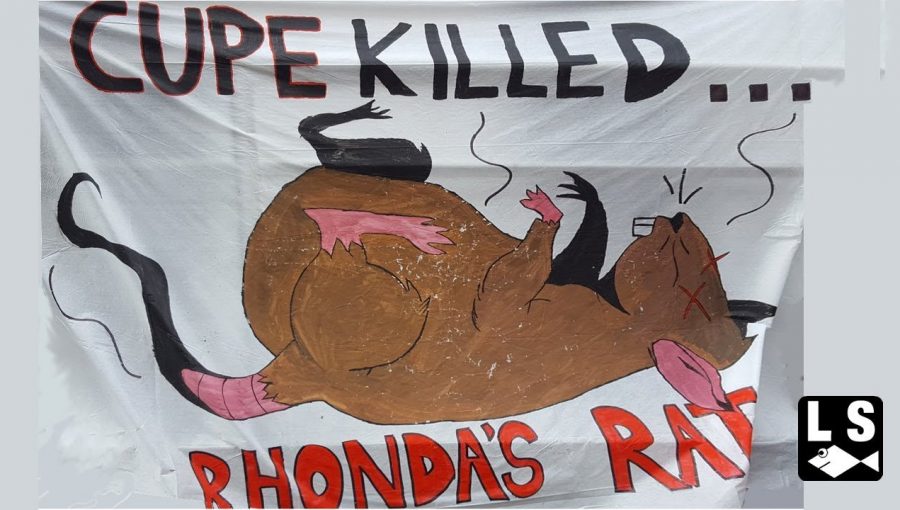Lessons Learned: Assessing the 2009 City of Toronto Strike
When word came that the 39-day strike by CUPE Locals 79 and 416 had come to an end, the immediate question on most members’ minds was “Did we win?” The information gap between rank and file members and the union executive was so large that many strikers were unaware of why exactly they were on strike in the first place and were dependent on media reports to find out where both sides stood during collective bargaining. Much of the information that picketing workers did receive was inconsistent, late or completely empty of any substantive information, leaving strikers frustrated and angry.
Post-strike assessments are never as simple as “did we win or lose?” In this article we offer our interpretation of the strike and the lessons learned from a tumultuous summer when thousands of municipal workers walked picket lines in Toronto. As members of Local 79, we focus on our local. We will not discuss the broad background to the strike that has been written about by others: neoliberal urbanism, City Council’s efforts to reduce social services and seek concessions from its unionized and non-unionized workers and its renewed interest in privatizing city assets, contracting out, increasing the number of public-private partnerships and shifting away from commercial property taxes to consumption-based levies (see articles by Greg Albo and Herman Rosenfeld and by Carlo Fanelli in The Bullet).
The Unions
CUPE Local 79, the largest public-sector union local in the country, represents over 18 000 workers including public health nurses and educators, health inspectors, child care workers, recreation staff, by-law enforcement officers, building inspectors, court service workers and social services administrators. Some of its members are deemed “essential” and did not strike. Approximately 70% of Local 79’s members are women. Some 50% are members of racialized groups. At least half are employed in part-time, seasonal and contingent forms of employment, with inconsistent hours and without the supplemental health benefits enjoyed by full-time employees. The 6000 members of Local 416 mostly work in road maintenance, water treatment, parks, cleaning, animal services and waste collection.
Many on the left praised the locals’ bravery for standing up for workers’ rights and fighting concessions. However, much less has been written on the shortcomings of both Locals’ strategies and tactics and their leading officers’ lack of transparency with members.
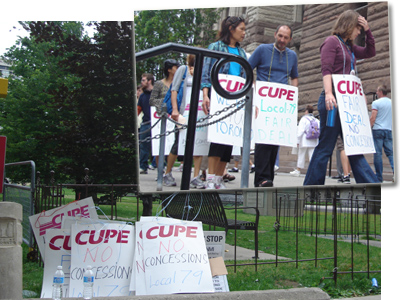
After the 2002 strike by City of Toronto workers was ended with back-to-work legislation (see the interview with Julia Barnett and Claudia White in New Socialist 37, online at newsocialist.org), activist union members raised the need to be prepared well in advance of a possible strike in terms of planning, coordination, and mobilization and to try to develop new strategies. Some members were openly critical of Local 79’s leadership. Others were more hesitant for fear of weakening solidarity or out of the hope that they could change the leadership’s policy from within. However, in the years since the 2002 strike there were no sustained efforts to regenerate union involvement or to democratize the union and prepare for a future strike.
Stumbling into a Strike
Fast-forward to 2009. Both local leaderships entered into bargaining with the understanding that the City would be attacking the controversial Sick Leave Benefit Program (SLBP), trying to weaken job security provisions, attack seniority rights, limit transfers and promotion, impose a freeze on cost-of-living increases to wages, implement two-tier wage schemes and increase managerial control over the work day. Mayor Miller and his minions argued that “The world has changed” and the City needed to cut back on its costs. This, of course, did not stop Miller and co. from settling with unionized workers in public transit, police, fire, parking authority and housing services.
In spite of bargaining for six months without a contract, Local 79’s executive gave little indication of how far apart the two sides were or what employer demands for concessions were on the table. With only hours remaining before both unions went on strike, the Local 79 executive refused to put together the best possible strike coordinating team. CUPE not only failed to engage its members but, aside from a few ill-advised radio ads, did not engage other workers in Toronto with any educational campaigns. No connection was made between communities and public-sector jobs and services or why it is important to support workers defending decent employment conditions and wages.
Local 79 President Ann Dembinski was confident that Mayor Miller would come through for the public-sector unions that had backed his election campaigns and that a fair contract without any concessions would be reached. Much to the dismay of the union brass, management did not budge and both locals found themselves walking the line.
When Locals 79 and 416 officially went on strike many workers showed up to work only to find that they had been locked-out by the employer. Many of the 24 000 striking workers simply did not know where to go or what to do. Picketing sites were unknown, where and how to register for picket duties was unspecified except on the web site, picket captains had not been trained beforehand and there were few informational materials for members.
On Strike
Local 79 was unprepared in crucial ways. There was a lack of experienced organizers leading the strike. The local president had never been an organizer of a Local 79 strike nor had most of the current members of the executive. The union did not book activists off as full-time organizers far enough in advance. Financial and other resources were allocated in ineffective and inequitable ways across the city. Members with disabilities or health concerns were not adequately provided with modified strike duties. Even though Toronto is a very expensive city to live in, as the strike went on no hardship fund was set up. Strike pay coordination was initiated only after the strike had already begun. Meanwhile the Local 79 bargaining committee acted in almost complete isolation from the membership.
Picketers were essentially left to fend for themselves, strike offices were disorganized and many members experienced a lack of solidarity, resentment and marginalization. There were, of course, exceptions. Many experienced activists with a commitment to the membership and a strong sense of social justice did great work. On some lines a real sense of union solidarity was created and nurtured on some picket lines where workers united and the class antagonism between workers and the employer became clear.
During the strike members of many other union locals as well as community activists showed their solidarity with striking city workers in the form of strike support barbeques, media releases and public rallies. Unfortunately, though, the weakening, disorganization and ineffectiveness of the Canadian Labour Congress, the Ontario Federation of Labour and the Toronto and York Region Labour Council became apparent as the strike went on. This was evident in the lack of concerted mobilization efforts, little to no media time for pro-strike voices and an inability to link Toronto strikers’ struggles with the broader social justice movement. The left outside and inside Toronto’s unions was unable to mobilize in an effective way around the strike.
In contrast, right-wing critics had a field day blaming so-called “selfish” unionized workers. They pointed to the garbage piling up as well as Mayor Miller’s hesitation to go for the throats of striking city workers (even though he encouraged workers to cross the picket line). It didn’t take much to see that the campaign to win over public support was won hands-down by the right. Conservative organs such as the National Post, Globe & Mail, Toronto Sun, CTV and Global TV lined up against the strike. The allegedly liberal Toronto Star, CP24 and even some community newspapers did too, to a slightly lesser extent.
The Mayor, Council and the Outcome
The hypocrisy and untrustworthiness of Mayor Miller, accompanied by the silence of “progressive” councilors at City Hall, is worth a brief discussion. The mayor attempted to pit striking City workers against workers in the most poverty-stricken and destitute living situations by arguing that “due to the economic downturn and rising welfare caseloads the City can’t sustain workers’ wages.” Not once did the mayor target the structural reasons why the City was having financial problems, including two decades of federal and provincial governments offloading services and responsibilities onto municipalities without providing matching fiscal support, Council’s redistributive shifting of taxation from higher-income earners to lower- and medium-income earners, Council’s generous tax breaks, subsidies and under-valued land-assessments for multi-million dollar developers, future infrastructure costs rising well into the tens of billions, rising poverty, inequality, homelessness, the lack of affordable housing and unemployment in the city. Instead, the mayor, Council, business sectors and right-wing populists used the gutless excuse of the recession to justify their attacks on City workers. They blamed the City of Toronto’s workers for a crisis they played no part in creating.
After the strike, both left-wing and right-wing commentators proclaimed Locals 416 and 79 victorious, for very different reasons. But more unpacking and analysis is needed.
The unions’ bargaining platform was simple: equality with the settlements recently reached by other unionized workers at the City of Toronto and no concessions. Economically, the unions managed to fight off major concession demands to freeze wages, institute a multiple-tiered wage system, limit seniority-based promotion and replace the banking of sick days and cash-payouts under the SLBP with a short-term disability (STD) plan now called the Illness and Injury Plan (IIP).
Under the deal to end the strike, current workers are able to cash-out their accumulated sick-bank and switch to the IIP plan or keep their existing SLBP. The SLBP is not available to new hires.
After going nearly a decade without wage increases throughout the 1990s, Locals 79 and 416 were successful in gaining 2% raises over 3 years, still below what other City of Toronto unions received and below City Council’s own 2.4% pay increase (not to mention their retention of their own “merit” bonuses and severance packages). The other concessions were taken off the table. With this settlement, the Local 79 part-timers still do not have a sick plan.
When members asked Local 79 President Ann Dembinski on numerous occasions what was wrong with a STD plan – such as the one that members of Local 79 who were formerly employed by the City of York before the amalgamation of Toronto municipalities in 1998 still have – she dismissed and ignored the question. During the strike the fabled SLBP got the bulk of attention from the media (along with the piles of trash). The hard-line union posture that “we do not make any concessions” frustrated many who thought that fighting for the best possible STD plan would have been a better idea than simply defending the existing SLBP that allows workers to bank sick days.
The SLBP had long been used by management as a way to limit wage and benefit increases. It also encourages workers to show up to work unwell so that they can cash-out unused sick days at a later point in time. But any critique of this by members was interpreted as breaking Local 79’s age-old rule of blind obedience and devotion to the union executive.
While the economic gains of the strike may be interpreted as a success for City workers, the strike was a political failure when it came to mobilizing sustained action and education, garnering public support as well as linking the defence of unionized jobs with fighting for workers in non-unionized jobs, the underemployed and the unemployed. If any argument should have been made during the City of Toronto strike, it should have been based on better and greener jobs for all. Illusions about the strike being a victory only serve to politically disarm workers in the face of the ruling class’s preparation for a fresh offensive, paving the way for further defeats.
Where Do We Go From Here?
Strategy and Vision
Using the economic recession as a justification, battered cities throughout Canada, the U.S. and elsewhere have already resorted to massive layoffs, cuts in services, selling off assets and imposing periods of unpaid time off. It likely won’t be long until that process is intensified in Toronto. During the strike there was no voice speaking up for the waged and unwaged working class.
This demonstrates the need for an organized and structured Left outside City Hall and independent from it. The shortcomings and limitations of the dispersed, localized and isolated Left in Toronto points to the need to break down sectarian barriers and think creatively about novel ways of reaching younger people and building a solid base.
The challenge for union and social justice activists is not to interpret the current attacks against workers or the current short-term fiscal liabilities of cities as a temporary problem, but as part and parcel of the day-to-day operations of capitalism. The exploitation of the current economic crisis by big business, finance and governments is a conscious strategy that aims to make long-term gains for capital in its control over labour and to continue to tip the balance of power toward capital.
Ruling classes are currently setting the agenda for the “re-regulation” of the economy as well as the reconstitution and reconsolidation of ruling-class power while the passivity and submissiveness of the working classes reaches epic proportions. It wasn’t too long ago that workers were up in arms protesting the exorbitant bailouts of billion-dollar companies with public funds, thereby aggravating balance of payments deficits and restarting the speculative fervor of financial markets. The dynamism of neoliberalism is demonstrated by the fact that social democrats – including the “progressive” coalition at Toronto City Hall – were absorbed and incorporated into the neoliberal project. Neoliberalism is not dead and it is certainly not gone.
Unfortunately, decades of bureaucratic unionism and the decline of the left have pacified much of the rank and file membership of the unions. The low level of support for unionized workers’ struggles suggests that most workers have become used to lowered expectations. Union rank and file members must come to expect more from their organizations and those who hold union office. However, this shouldn’t simply be about higher expectations but new and different expectations – in other words, expectations that go beyond those of the past.
With this in mind, in CUPE 79 we are in the midst of once again attempting to build a reform caucus within that will attempt to democratize our local by calling for and organizing workplace meetings, demanding transparency from the official leadership and engaging in democratic decision making, relevant campaigns, and open political debate. We encourage other unionists to do the same.
Looking ahead, if unions are to reappear as a movement and not simply hang on as a relic of the past, they need to move beyond simply the interests of members in the workplace and really begin thinking about new strategies and tactics to build a broader working class movement across the many divisions among workers including those rooted in racism, sexism, heterosexism and the oppression of people with disabilities.
In other words, there needs to be a move away from corporate unionism toward social movement unionism infused with a deep critical analysis of capitalism. More people need to understand that as long as our lives are left to the devices of markets, competition and profits, a society supportive of solidarity and equality will remain an intangible reality. To achieve such a society, we need democratic social planning to meet collective needs and wants. •
This article first appeared in Relay #28 and New Socialist.


